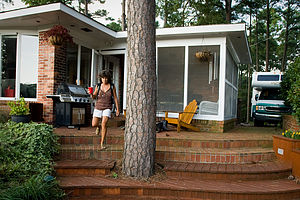- Home
- About
- Map
- Trips
- Bringing Boat West
- Migration West
- Solo Motorcycle Ride
- Final Family XC Trip
- Colorado Rockies
- Graduates' XC Trip
- Yosemite & Nevada
- Colorado & Utah
- Best of Utah
- Southern Loop
- Pacific Northwest
- Northern Loop
- Los Angeles to NYC
- East Coast Trips
- 1 Week in Quebec
- Southeast Coast
- NH Backpacking
- Martha's Vineyard
- Canadian Maritimes
- Ocracoke Island
- Edisto Island
- First Landing '02
- Hunting Island '02
- Stowe in Winter
- Hunting Island '01
- Lake Placid
- Chesapeake
- Provincetown
- Hunting Island '00
- Acadia in Winter
- Boston Suburbs
- Niagara Falls
- First Landing '99
- Cape Hatteras
- West Coast Trips
- Maui
- Mojave 4WD Course
- Colorado River Rafting
- Bishop & Death Valley
- Kauai
- Yosemite Fall
- Utah Off-Road
- Lost Coast
- Yosemite Valley
- Arizona and New Mexico
- Pescadero & Capitola
- Bishop & Death Valley
- San Diego, Anza Borrego, Joshua Tree
- Carmel
- Death Valley in Fall
- Yosemite in the Fall
- Pacific Northwest
- Utah Off-Roading
- Southern CA Deserts
- Yosemite & Covid
- Lake Powell Covid
- Eastern Sierra & Covid
- Bishop & Death Valley
- Central & SE Oregon
- Mojave Road
- Eastern Sierra
- Trinity Alps
- Tuolumne Meadows
- Lake Powell Boating
- Eastern Sierra
- Yosemite Winter
- Hawaii
- 4WD Eastern Sierra
- 4WD Death Valley +
- Southern CA Deserts
- Christmas in Tahoe
- Yosemite & Pinnacles
- Totality
- Yosemite & Sierra
- Yosemite Christmas
- Yosemite, San Diego
- Yosemite & North CA
- Seattle to Sierra
- Southwest Deserts
- Yosemite & Sierra
- Pacific Northwest
- Yosemite & South CA
- Pacific Northwest
- Northern California
- Southern Alaska
- Vancouver Island
- International Trips
- Index
- Tips
- Books
- Photos/Videos
- Search
- Contact
Home
Sunday, August 22, 2010 - 11:00am by Lolo265 miles and 5 hours from our last stop - 1 night stay
Travelogue
Too bad the weather had put a damper on our last two days and caused us to cut our vacation a day short, because otherwise it had been a really great trip—not as dramatic and exciting as some our trips in the past, but really fun nonetheless.
Now it was time to get back to reality. Andrew had the GREs in 3 days and Tommy had to head back up to school the following weekend to lead a freshman orientation backpacking trip. After spending so much time together over the last week, I wasn’t sure whether I was looking forward to or dreading how quiet the house would be when they left. In either case, it is what it is and we would adjust once more.
Description
Our home in Upper Saddle River, a suburb of New York City.
Ausable River Campground
Saturday, August 21, 2010 - 10:45am by Lolo174 miles and 4 hours from our last stop - 1 night stay
Travelogue
We just couldn’t leave Canada without having a donut and coffee at a Tim Hortons, so right before reaching the border, we made this obligatory stop. Also, I figured it would give me a chance to get rid of the Canadian money I had left in my wallet.
The border crossing was a breeze once again, and we soon found ourselves on the familiar Adirondack Highway, pretty much a straight line home for us. However, since it was already dinner time and the rainy driving conditions weren’t great, we decided to find a place to stay for the night and then just finish up the drive in the morning.
I consulted the Woodall’s guide for a campground that wouldn’t take us too far off route. Somewhat subconsciously, I think I was also looking for something that might be fun if the weather cleared the next morning. The Ausable River Campground, just a short distance off Exit 35 seemed about right, and very near to a place I remember visiting when I was a child, Ausable Chasms.
We followed the signs for the campground and eventually pulled down a dark road past a dark deserted campground office. We weren’t sure what to do, but we certainly didn’t want to continue driving any further, so we continued driving along the road past the office into the campground itself. We noticed several empty sites in the woods along the way before coming to a more open area full of happy, partying campers. What a contrast with the deserted and quiet wooded sites we had just passed through. This was the area down by the Ausable River, and I guess it was where all the action was, rather than back in the woods. Eventually, we found the owners’ campsite and asked if we could have a site for the night. She looked in the RV, saw the boys, and suggested that we might want a site down here so the boys could socialize with the other young campers. Herb and I had to laugh, because we knew that was not even remotely on their agenda for the night. We politely declined and took a site back up in the woods towards the entrance.
Unfortunately, the next morning we woke up to more rain, and I knew that my hope of squeezing a little more vacation out of this trip was over. Oh well, it was time to head home.
Description
The Ausable River Campground is located on Route 9, just off I87 between Exits 34 and 35. It is 12 miles south of Plattsburgh, NY.
The 120-site campground is located on 130 acres along the Ausable River within the Adirondack Park. Activities include fishing, boating, and swimming on the Ausable River as well as bicycling or walking along its wilderness trails.
The most popular nearby attraction is Ausable Chasms, a 2-mile-long sandstone gorge through which the Ausable River flows. It is fed by the Rainbow Falls at its southern extreme, and eventually empties into Lake Champlain. There is a 2-mile “Rim Walk” along the edge of the rim looking down into the chasm, as well as low-key raft rides through the gorge.
The following is the website for Ausable Chasms: http://www.ausablechasm.com/assets/pdf/Welcome_map.pdf
Parc du Mont-Sainte-Anne
Thursday, August 19, 2010 - 11:00am by Lolo37 miles and 1 hour from our last stop - 1 night stay
Travelogue
 Boys running from Parc du Mont-Sainte-Anne CampgroundAfter a very satisfying lunch in Baie St. Paul we continued on to our planned destination for the night: the Parc du Mont-Sainte-Anne. We had decided to add this park to our itinerary after a father and son that we met on the Isle-aux-Coudres, who came from Mont-Sainte-Anne, told us that it had miles and miles of trails for mountain biking and running. Plus it wasn’t too far off our route to the Parc National du Mont-Tremblant where we had camping reservations for the weekend.
Boys running from Parc du Mont-Sainte-Anne CampgroundAfter a very satisfying lunch in Baie St. Paul we continued on to our planned destination for the night: the Parc du Mont-Sainte-Anne. We had decided to add this park to our itinerary after a father and son that we met on the Isle-aux-Coudres, who came from Mont-Sainte-Anne, told us that it had miles and miles of trails for mountain biking and running. Plus it wasn’t too far off our route to the Parc National du Mont-Tremblant where we had camping reservations for the weekend.
I had mentioned in the previous stop that there is a different sort of feeling that one gets when the half way, or now heading towards home, point of a trip is reached, but I think none of us felt it as hard as Andrew, who was scheduled to take the GREs a few days after our return home. It was time to really kick into gear on the studying, and I must say he really did. However, being confined together in such close quarters, we had to find a way for him to do this without driving the rest of us crazy. Going through his little box of the 500 most commonly used words on the GRE and using them on us whenever appropriate, and oftentimes when not even remotely appropriate, definitely improved our vocabulary, but began to get on our nerves. Then there were the timed practice tests where we all had to be quiet so he could concentrate. This was not going to work. Tommy was ready to choke him.
 Lolo Swinging AroundWhen we got to the campground in Mont-Sainte-Anne, he was banished to a picnic table on a nearby vacant campsite, where he could take his practice tests undisturbed, and we could speak above a whisper. I was quite proud of him; this was vacation after all, and he was working awfully hard. Hopefully his efforts would pay off.
Lolo Swinging AroundWhen we got to the campground in Mont-Sainte-Anne, he was banished to a picnic table on a nearby vacant campsite, where he could take his practice tests undisturbed, and we could speak above a whisper. I was quite proud of him; this was vacation after all, and he was working awfully hard. Hopefully his efforts would pay off.
Herb and I decided to take our bikes to explore the campground and try to figure out the mountain biking trails. It was really a very nice campground with spacious, wooded, sites. A short distance from our site there was a small lake for swimming and a bit further on we came across a feature that I had never seen in a campground before—an animal farm, complete with goats and sheep. The mountain biking trails that led from the campground were a little more confusing than we had anticipated, and we weren’t sure exactly where we were going. At one point we came out of the woods onto a big playground that I could not picture being allowed to exist in the U.S. It was actually very cool. Besides trampolines, old fashioned see-saws, and a device you could hang on and swing madly around a pole, there was an entire obstacle course with fences to climb, tunnels to go through, rope bridges to cross, etc. Rather than injuring myself right way, I decided to come back later with the boys—they hate missing an opportunity to see me do something foolish.
 Parc du Mont-Sainte-Anne Llama?Part of our objective for this bike ride was to find a good trail for the boys to go on a long run, but the ones we went on were confusing and not particularly great for running. Having nothing better to report back to them, I suggested they run along the road back out to Route 360, where the map showed a trail that ran alongside the highway. While they did that, Herb and I went out for a run too and headed in the same direction that they went. However, shortly after leaving the campground, we noticed a sign for the Le circuit Jean-Larose trail that led off to the right into the woods. It traced a lovely stream through a peaceful forest for most of its 7.5 km before ending at the parking lot at the base of Mont-Sainte-Anne. I only wish I had known about this trail before the boys went out on their run. It would have been so much nicer running along this wooded stream than along a boring road. They did, however, get to run this trail early the next morning before we left for Mont-Tremblant.
Parc du Mont-Sainte-Anne Llama?Part of our objective for this bike ride was to find a good trail for the boys to go on a long run, but the ones we went on were confusing and not particularly great for running. Having nothing better to report back to them, I suggested they run along the road back out to Route 360, where the map showed a trail that ran alongside the highway. While they did that, Herb and I went out for a run too and headed in the same direction that they went. However, shortly after leaving the campground, we noticed a sign for the Le circuit Jean-Larose trail that led off to the right into the woods. It traced a lovely stream through a peaceful forest for most of its 7.5 km before ending at the parking lot at the base of Mont-Sainte-Anne. I only wish I had known about this trail before the boys went out on their run. It would have been so much nicer running along this wooded stream than along a boring road. They did, however, get to run this trail early the next morning before we left for Mont-Tremblant.
After the boys got back to the campground, and confirmed that my suggested run was indeed boring, I asked them to come with me to the “extreme” playground that I found. We went through the obstacle course together, swung around on the crazy swing, and generally had a lot of laughs, most of them at my expense.
Description
 Extreme Lolo on Obstacle CourseThe Parc du Mont-Sainte-Anne is a very popular, year-round wilderness resort centered around the 2,625 foot mountain of the same name.
Extreme Lolo on Obstacle CourseThe Parc du Mont-Sainte-Anne is a very popular, year-round wilderness resort centered around the 2,625 foot mountain of the same name.
Winter activities in the park include downhill skiing, cross-country skiing, dog-sledding, snowshoeing, and snowmobiling. It was named by Ski Canada as the best spring skiing destination in the east.
In summer and fall, the mountain and its surrounding area turns into a mountain biker’s paradise, and even served as the host of the 2010 Mountain Bike and Trail World Championships. Besides the hard core trails down the mountain itself, there are miles and miles of much milder trails for all levels of expertise.
Parc du Mont-Sainte-Anne is located just 40 minutes northeast of Quebec City. To get to the park, exit off of Route 138 onto Route 360 east near the town of Ste-Anne-de-Beaupré.
There is a 166-site campground within the park, just 7 km east of the alpine ski area. The campground has a large lake for swimming, mountain bike trails, a playground, and even an animal farm.
La Malbaie
Wednesday, August 18, 2010 - 10:15am by Lolo25 miles and 1 hour from our last stop
Travelogue
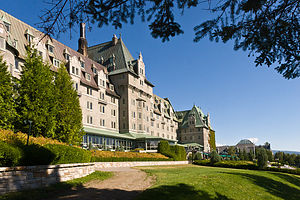 Fairmont Le Manoir RichelieuWe had a full-day planned—a stop in La Malbaie to do a little gambling—Tommy’s idea, as he is 19 and too young to gamble in the U.S.—and then onto the town of Tadoussac, to hopefully spot some whales in Saguenay Bay.
Fairmont Le Manoir RichelieuWe had a full-day planned—a stop in La Malbaie to do a little gambling—Tommy’s idea, as he is 19 and too young to gamble in the U.S.—and then onto the town of Tadoussac, to hopefully spot some whales in Saguenay Bay.
We didn’t even stop for breakfast or to fully wake up the boys, but just headed out to catch the 7:00 ferry to Saint-Joseph-de-la-Rive. I think Herb was in a hurry to just get that 18% grade hill behind us, which by the way he was now referring to as the “Drive of Death,” or more romantically in French, the “Trajet de Mort.” I don’t think it was as bad as we expected. We just threw it in low gear and chugged along slowly up the hill. We stopped at a scenic pullout to have breakfast and rest the transmission. The views of the river and Isle-aux-Coudres in the distance were quite lovely; equally lovely to Herb was the fact that most of the hill was now below us.
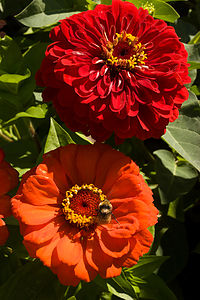 French speaking BumblebeeOur route took us along the scenic Route du Fleuve, up and down hills with frequent views of the river to our right. We skipped stopping at the village of St-Irenee and continued on directly to La Malbaie where we found a large, very RV friendly parking lot near the famous hotel, the Fairmont Le Manoir Richelieu. At the parking lot’s edge, there was an interesting trail that ran along the bluff above the river. To the right the trail went off into the woods, but to the left it led to the hotel and casino. We went left, and in a very short time arrived at a terraced patio outside the very impressive Norman-style chateau, where guests were delightfully dining al fresco. The boys and I went in to the hotel to have a peak, while Herb remained outside to take some photos. We later found him relaxing in one of the Adirondack chairs looking out over the water. What a beautiful place. No wonder the rich and famous Americans of the late 19th and early 20th century came here to vacation.
French speaking BumblebeeOur route took us along the scenic Route du Fleuve, up and down hills with frequent views of the river to our right. We skipped stopping at the village of St-Irenee and continued on directly to La Malbaie where we found a large, very RV friendly parking lot near the famous hotel, the Fairmont Le Manoir Richelieu. At the parking lot’s edge, there was an interesting trail that ran along the bluff above the river. To the right the trail went off into the woods, but to the left it led to the hotel and casino. We went left, and in a very short time arrived at a terraced patio outside the very impressive Norman-style chateau, where guests were delightfully dining al fresco. The boys and I went in to the hotel to have a peak, while Herb remained outside to take some photos. We later found him relaxing in one of the Adirondack chairs looking out over the water. What a beautiful place. No wonder the rich and famous Americans of the late 19th and early 20th century came here to vacation.
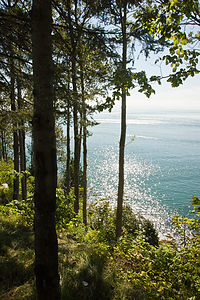 Fairmont Le Manoir Richelieu water viewA little bit further along the path we came to the casino, which wasn’t even open yet. While waiting outside, we discussed our strategy. Herb’s strategy for success was to not even enter the casino—he hates gambling. I think it all goes back to some childhood trauma where he bet and lost the entire contents of his piggy bank to his father, who was teaching him a lesson about the risks of gambling. Apparently, it worked and he hasn’t gambled since. The boys and I saw things differently and thought that everything, or almost everything, should be tried once. As long as we could maintain some control and stick to our plan of only betting up to $20, we thought that we couldn’t lose. After all, we would pay that much for the experience of a movie or bowling, so even if we lost it all, we were still the better for our experience, or some logic like that.
Fairmont Le Manoir Richelieu water viewA little bit further along the path we came to the casino, which wasn’t even open yet. While waiting outside, we discussed our strategy. Herb’s strategy for success was to not even enter the casino—he hates gambling. I think it all goes back to some childhood trauma where he bet and lost the entire contents of his piggy bank to his father, who was teaching him a lesson about the risks of gambling. Apparently, it worked and he hasn’t gambled since. The boys and I saw things differently and thought that everything, or almost everything, should be tried once. As long as we could maintain some control and stick to our plan of only betting up to $20, we thought that we couldn’t lose. After all, we would pay that much for the experience of a movie or bowling, so even if we lost it all, we were still the better for our experience, or some logic like that.
So when the doors of the casino opened, we and our $20 were the first ones in. Tommy was immediately IDed, but proudly displayed his license and was waved through. We spent quite some time wandering around, assessing which machine would offer us the biggest jackpot. We wanted to stay away from the tables, because we really didn’t know what we were doing, and the bets required at the tables would cause us to blow through our $20 far too quickly. I was hoping to find a $1 blackjack machine. I had fond memories of spending hours on one of these machines in Atlantic City when I was the boys’ age. I was convinced at the time that I had an unbeatable system. Every time I lost, I doubled my bet. By the end of the day, I had exactly broken even and left Atlantic City proudly with my $20 in tact. Unfortunately, we couldn’t find a blackjack machine, so we dabbled on a few slots instead. After mostly losing with a few sporadic wins, we eventually fought our way back up to $17. We considered ourselves winners and called it quits.
Having accomplished what we had come to do, we decided to move on towards Tadoussac.
Description
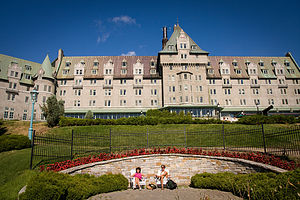 Parents at Fairmont Le Manoir Richelieu - AJGThe town of Malbaie is located in the Charlevoix region of Quebec, 87 miles northeast of Quebec City. It can be reached via Route 138, which is the major highway through the region, or by the much more scenic Route du Fleuve (“River Route”) or Route 362, which winds its way for 30 miles from the villages of Baie-St-Paul to La Malbaie along the cliffs overlooking the river. The views along the River Route are spectacular.
Parents at Fairmont Le Manoir Richelieu - AJGThe town of Malbaie is located in the Charlevoix region of Quebec, 87 miles northeast of Quebec City. It can be reached via Route 138, which is the major highway through the region, or by the much more scenic Route du Fleuve (“River Route”) or Route 362, which winds its way for 30 miles from the villages of Baie-St-Paul to La Malbaie along the cliffs overlooking the river. The views along the River Route are spectacular.
La Malbaie is situated at the mouth of the Malbaie River, where it flows into the St. Lawrence. It was formerly known as Murray Bay by the wealthy Americans who have been vacationing here since the Gilded Age of the late 19th century. President William-Howard Taft was a frequent visitor.
La Malbaie is home to the Charlevoix region’s grandest resort: the Fairmont Le Manoir Richelieu, often referred to as “the castle on the hill.” This Norman-style chateau, complete with towers and turrets, was built in 1899 to accommodate the aristocratic tourists that came to enjoy its luxurious décor and the spectacular views of the St. Lawrence River.
Another major draw to the town is the Charlevoix Casino with its 950 slot machines and 24 tables, including Texas hold-em, blackjack, roulette, and minibaccarat. Visitors must be 18 years or older.
Northway Rest Area
Sunday, August 15, 2010 - 6:30pm by Lolo208 miles and 3.5 hours from our last stop - 1 night stay
Travelogue
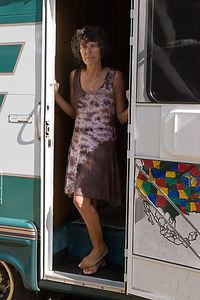 Lolo of the RVWe often like leaving late afternoon or early evening of the day prior to our planned departure. It always gives us the impression of getting a jump on things. That way the first “real” day of vacation is not just driving, but can contain some actual fun.
Lolo of the RVWe often like leaving late afternoon or early evening of the day prior to our planned departure. It always gives us the impression of getting a jump on things. That way the first “real” day of vacation is not just driving, but can contain some actual fun.
So we headed out of the driveway around 8:00 pm – we didn’t want to get to our less than exciting destination too early, as there is not too much to entertain yourself with at a Rest Area or a Walmart parking lot. You want to be nice and sleepy by the time you arrive, so that you can just pull down the shades and pretend you are somewhere else.
I had thoroughly researched our possibilities of a free overnight camping spot along the Northway. Although several travel blogs indicated that it was fine to spend the night in a Rest Area, just to be safe I wrote an email to the Adirondack Northway authorities to ask—probably not the best idea, as I think the policy is an unstated and unofficial one. I was told that the state frowns on camping in rest areas, but that a few hours would be okay, as long as we didn’t idle the motor. However, he did give me two other good ideas: a truckstop at Exit 36 and a Walmart at Plattsburgh Exit 37.
Despite the official advice, we did spend the night at the Schroon Lake Rest Area. It was just so much more convenient to stay on the highway than trying to find the Walmart. We figured we couldn’t get in too much trouble, as, after all, we were officially told we could sleep a few hours. How were they to know that we weren’t just there for just a few hours, and few is a rather subjective term. I even brought along the email, just in case.
We slept fine and rose early to head towards the border. The boys always look forward to a good border search. For some reason, me acting all nervous like I am trying to hide something seems to entertain them. We actually experienced a quite thorough one when we went to Campobello Island in 2004. I told them that it was not our goal to repeat this experience.
Description
Interstate I87 runs 334 miles along the eastern edge of New York State from the Bronx all the way to the Canadian border, where it continues towards Montreal as Autoroute 15. The portion of I87 south of Albany is called the New York State Thruway, and it has several full-service rest areas. Once you get north of Albany, the name of I87 changes to the Adirondack Northway. While there are still several rest stops on the Adirondack Northway, they do not have restaurants or gas stations. However, they do have picnic areas, vending machines, and restrooms.
There are nine rest stops along the Adirondack Northway between Albany and the Canadian border. The following is a link describing their locations and facilities: http://www.adirondacknorthway.net/exits/nbreststops.php
Although the state does not sanction camping overnight in these rest stops, you are officially allowed to spend a few hours resting there, as long as you are not idling your motor.
Nineteen Mile Brook Trailhead
Tuesday, June 9, 2009 - 11:00am by Andrew4 miles and 2 hours from our last stop
Travelogue
 Drying Clothes Woke up at 6:00 feeling very well-rested. I stepped out onto our porch into bright sunlight, which had nicely dried our socks, which had been carefully draped over the wooden railing. This would be our last day on the trail - a mere 3.8 miles on the Nineteen Mile Brook Trail, leading to Route 16 where we could conveniently catch a shuttle bus that would bring us back to the Liberty Springs Trailhead at Franconia State Park - our starting destination from a week earlier. I had mixed feelings about our trip coming to an end. While my body was incredibly fatigued and I craved a shower to cleanse the 7 days of sweat and dirt from by body, I wasn't sure that I was ready to remove myself from the extremely simple and enjoyable lifestyle that I had now grown so accustomed to. We had covered a huge variety of beautiful landscape over the past week, but in essence every day was essentially the same - wake-up, eat, walk, eat, walk, eat, sleep. I had gotten pretty used to this lifestyle and I wasn't sure that I was ready to give it up for the more civilized existence I would be forced to adapt to when I arrived home.
Drying Clothes Woke up at 6:00 feeling very well-rested. I stepped out onto our porch into bright sunlight, which had nicely dried our socks, which had been carefully draped over the wooden railing. This would be our last day on the trail - a mere 3.8 miles on the Nineteen Mile Brook Trail, leading to Route 16 where we could conveniently catch a shuttle bus that would bring us back to the Liberty Springs Trailhead at Franconia State Park - our starting destination from a week earlier. I had mixed feelings about our trip coming to an end. While my body was incredibly fatigued and I craved a shower to cleanse the 7 days of sweat and dirt from by body, I wasn't sure that I was ready to remove myself from the extremely simple and enjoyable lifestyle that I had now grown so accustomed to. We had covered a huge variety of beautiful landscape over the past week, but in essence every day was essentially the same - wake-up, eat, walk, eat, walk, eat, sleep. I had gotten pretty used to this lifestyle and I wasn't sure that I was ready to give it up for the more civilized existence I would be forced to adapt to when I arrived home.
 Nineteen Mile Brook TrailAnyway, we said farewell to our new friends at Carter Notch Hut and hit the trail. The hike back was a relatively easy trail - wide and well-maintained - that ran along a nice little brook. We were pretty much all business on the way back - no snack or photo breaks as we wanted to ensure that we wouldn't miss the shuttle bus picking us up at the parking lot at Route 16. It turned out that this wouldn't be an issue, as the guy driving the AMC Shuttle was a good 25 minutes late, which gave us plenty of time to goof around in the parking lot taking pictures at the trailhead, eating nutella, doing abs, and even eating nutella while doing abs.
Nineteen Mile Brook TrailAnyway, we said farewell to our new friends at Carter Notch Hut and hit the trail. The hike back was a relatively easy trail - wide and well-maintained - that ran along a nice little brook. We were pretty much all business on the way back - no snack or photo breaks as we wanted to ensure that we wouldn't miss the shuttle bus picking us up at the parking lot at Route 16. It turned out that this wouldn't be an issue, as the guy driving the AMC Shuttle was a good 25 minutes late, which gave us plenty of time to goof around in the parking lot taking pictures at the trailhead, eating nutella, doing abs, and even eating nutella while doing abs.
 Sit-ups while eating NutellaThe shuttle finally showed up and we each gave the nice old man $19 for a ride back. We were the only two on the bus and the driver was very keen on talking to us. Unfortunately we couldn't really understand what this guy was saying, so the conversation involved a lot of "Oh, yeah's" and "uhhum's" on our end. This shuttle ride also involved a layover at the Highland Visitors Center in Crawford Notch, where our driver informed us that he would be taking an hour lunch break. Fortunately it was a beautiful day, so Nik and I didn't mind the opportunity to lounge around and check things out. I couldn't help but buy myself an overpriced turkey sub at the food place in the Visitors Center. Nik, however, had more will-power than I and refrained from paying for a sandwich, opting for leftover peanut butter, powerbars, and cheese instead.
Sit-ups while eating NutellaThe shuttle finally showed up and we each gave the nice old man $19 for a ride back. We were the only two on the bus and the driver was very keen on talking to us. Unfortunately we couldn't really understand what this guy was saying, so the conversation involved a lot of "Oh, yeah's" and "uhhum's" on our end. This shuttle ride also involved a layover at the Highland Visitors Center in Crawford Notch, where our driver informed us that he would be taking an hour lunch break. Fortunately it was a beautiful day, so Nik and I didn't mind the opportunity to lounge around and check things out. I couldn't help but buy myself an overpriced turkey sub at the food place in the Visitors Center. Nik, however, had more will-power than I and refrained from paying for a sandwich, opting for leftover peanut butter, powerbars, and cheese instead.
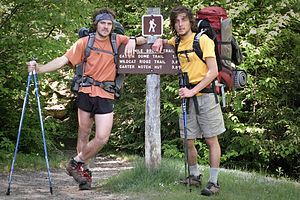 The Hike's EndpointEventually our driver was done with his lunch and was ready to bring Nik and I back to Liberty Springs. As we pulled into the parking lot, I was very pleased to see that the ol' Civic was still there in one piece. Rather than depart right away on the 6-hour trek back to New Jersey, we killed a good hour in the parking lot goofing around more - listening to music, taking pictures, etc. Morale was through the roof.
The Hike's EndpointEventually our driver was done with his lunch and was ready to bring Nik and I back to Liberty Springs. As we pulled into the parking lot, I was very pleased to see that the ol' Civic was still there in one piece. Rather than depart right away on the 6-hour trek back to New Jersey, we killed a good hour in the parking lot goofing around more - listening to music, taking pictures, etc. Morale was through the roof.
The drive back went smoothly. I drove the first half while Nik chilled, and then Nik drove the second half. The parents were certainly pleased to see us back home in one piece, but were less than thrilled with our grimy and greasy appearance that we had developed over the past 8 days. I took a shower almost immediately, while Nik may have waited another week or so to do so.
 The CivicAnd so our trip came to close. While there were certainly times on our 65 mile trek where we were both miserable, the hike was an overwhelming success. We had created enough memories that we could talk for hours hysterically recounting various anecdotes and encounters from our trip. While the contrast of our week of hiking and living in the wilderness with our normal everyday life was huge - each of them really makes you appreciate the other more. I could only wish there was more time spent hiking and less time spent in the "real-world", but I suppose there is always next summer. I can only wait and hope that my hiking partner feels the same.
The CivicAnd so our trip came to close. While there were certainly times on our 65 mile trek where we were both miserable, the hike was an overwhelming success. We had created enough memories that we could talk for hours hysterically recounting various anecdotes and encounters from our trip. While the contrast of our week of hiking and living in the wilderness with our normal everyday life was huge - each of them really makes you appreciate the other more. I could only wish there was more time spent hiking and less time spent in the "real-world", but I suppose there is always next summer. I can only wait and hope that my hiking partner feels the same.
Home
Thursday, August 20, 2009 - 3:15pm by Lolo382 miles and 6.5 hours from our last stop
Travelogue
Well, I have to admit it, that despite all my pre-trip concerns about the Southeast in August, this trip had actually been a lot of fun. It was much different from our other summer adventures – a little less adventure but a bit more play and relaxation -- but still very much worthwhile.
Also, we all had some pretty good tans to show off.
Description
Our home in Upper Saddle River, a suburb of New York City.
Friends' House in Virginia Beach
Tuesday, August 18, 2009 - 4:00pm by Lolo373 miles and 6.5 hours from our last stop - 2 night stay
Travelogue
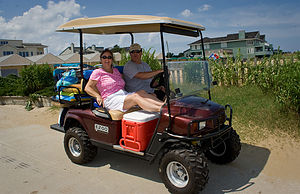 Dona & Scott with their Beach BuggyFortunately Donna and Scott are the type of friends upon whose doorstep you can arrive at dinner time, because that's exactly what we did.
Dona & Scott with their Beach BuggyFortunately Donna and Scott are the type of friends upon whose doorstep you can arrive at dinner time, because that's exactly what we did.
Our friendship went way back to a time before either of us had children. Then we both got pregnant—Donna and I that is, not Herb and Scott—at the same time (both times) and each of us produced two wonderful sons who got along as well as their parents did. It was perfect. There was someone for everyone. Now the boys were all fully grown and going off to college. Our lives always seemed to parallel each other. Their boys were even going to the same college together (William & Mary) as ours had chosen to do as well (Williams College). Our visit felt like we had never been apart.
We had been to Virginia Beach several times in the past, even before the Bleakleys moved here. There is a truly wonderful state park located right on the Chesapeake Bay near the bridge called First Landing State Park that we have stayed at several times in the past. Besides a lovely beach on the Bay it has miles of hiking and biking trails along lagoons, forested dunes, and bald cypress swamps. It’s one of the few places north of the Carolinas where the trees are draped with Spanish moss. This time, however, we were camping in the Bleakley’s driveway, a full-service campground with home-cooked meals and an open bar. They had a wonderful setup—a beautiful piece of property right on an inlet leading out to Chesapeake Bay, with their own dock to keep their boat at. And, it was also in easy biking distance to both First Landing State Park as well as the Atlantic Ocean beaches of Virginia Beach.
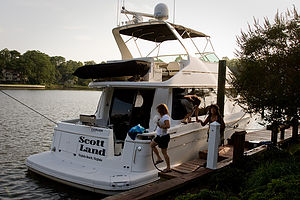 The "Scott Land"We certainly made the most of our one full-day together. In the morning, the adults bike rode along the Cape Henry Trail in First Landing State Park while the boys ran it. This really is one of my favorite trails. The soft surface is perfect for running and the scenery as it meanders alongside a cypress swamp through a Spanish moss draped forest makes you forget that you are actually exercising.
The "Scott Land"We certainly made the most of our one full-day together. In the morning, the adults bike rode along the Cape Henry Trail in First Landing State Park while the boys ran it. This really is one of my favorite trails. The soft surface is perfect for running and the scenery as it meanders alongside a cypress swamp through a Spanish moss draped forest makes you forget that you are actually exercising.
We decided to spend the afternoon at the beach, which was just a short bike ride away. Donna and Scott, however, were going to ride their new toy to the beach: a golf cart. We loaded it up with beach chairs, towels, and a giant cooler and set off. I couldn’t stop laughing the entire ride. Every time I looked at them, all I could think of was Fred and Wilma Flintstone. The beach was great fun, and had a perfect surf to play in.
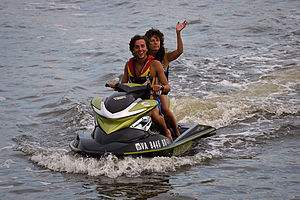 Andrew and Lolo on Jet SkiThe day wasn’t over yet. Scott still had some more fun toys to play with. He showed Andrew and Tommy how to drive his pair of jet skis and set them loose. They had a great time whizzing around the bay. We skipped the kayaks and went directly to Scott’s newest and largest toy, the Scottland, his 45 foot Carver. We grabbed some wine and hors d’oeuvres and headed out to sea – or at least to the bay. The boys met us on the jet skis and Andrew took me on a wild ride, which was very invigorating.
Andrew and Lolo on Jet SkiThe day wasn’t over yet. Scott still had some more fun toys to play with. He showed Andrew and Tommy how to drive his pair of jet skis and set them loose. They had a great time whizzing around the bay. We skipped the kayaks and went directly to Scott’s newest and largest toy, the Scottland, his 45 foot Carver. We grabbed some wine and hors d’oeuvres and headed out to sea – or at least to the bay. The boys met us on the jet skis and Andrew took me on a wild ride, which was very invigorating.
After dinner that night, we played another rowdy game of Catch Phrase, an old Bleakley/Gaidus classic. The previous night had resulted in a squeaker of a victory for the Gaiduses, or at least that’s the way I remember it. For this evening’s play, we broke up families and played the kids against the parents. Quicker reflexes and less wine consumption won the day, and the adults suffered a humiliating defeat.
The next morning we said goodbye to the Bleakleys and headed on home. Visiting with them had been a perfect way to wind down our trip.
Huntington Beach State Park
Monday, August 17, 2009 - 12:00pm by Lolo360 miles and 6 hours from our last stop - 1 night stay
Travelogue
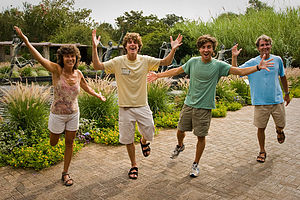 Family as 4 MusesHuntington Beach and Brookgreen Gardens was an old favorite of ours—an extremely unique combination of nature and art. Huntington Beach State Park alone would have been worth the stop, with its beautiful beaches and old Moorish castle, but the proximity of a world-class sculpture garden just across the road made it one of our favorites.
Family as 4 MusesHuntington Beach and Brookgreen Gardens was an old favorite of ours—an extremely unique combination of nature and art. Huntington Beach State Park alone would have been worth the stop, with its beautiful beaches and old Moorish castle, but the proximity of a world-class sculpture garden just across the road made it one of our favorites.
The drive from Anastasia State Park near St. Augustine to Huntington was a pretty long one, close to 7 hours. Since we only had one night to spend at Huntington, and there were so many things we wanted to do, I kept anxiously looking at my watch along the drive, hoping that we would arrive early enough to spend some time that afternoon at Brookgreen Gardens before they closed at 5:00. There are a lot of really beautiful state parks along the beaches of South Carolina, Georgia, and Florida, but only Huntington has Brookgreen.
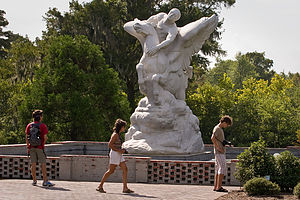 Lolo & Boys photographing Brookgreen GardensHuntington Beach State Park and Brookgreen Gardens have a common history. Back in the 1930s, the sculptress Anna Hyatt Huntington and her husband purchased the land that both the State Park and the gardens are on today. They built an intriguing Moorish-style castle, which they named Atalaya, on the grounds of what is today the State Park and used it as a winter retreat. They used the land across the road, which is today Brookgreen Gardens, to display their extensive sculpture collection. Today the gardens cover 50 acres and contain more than 900 sculptures, spanning the entire history of American sculpture. Now you know why we were in such a rush to get there.
Lolo & Boys photographing Brookgreen GardensHuntington Beach State Park and Brookgreen Gardens have a common history. Back in the 1930s, the sculptress Anna Hyatt Huntington and her husband purchased the land that both the State Park and the gardens are on today. They built an intriguing Moorish-style castle, which they named Atalaya, on the grounds of what is today the State Park and used it as a winter retreat. They used the land across the road, which is today Brookgreen Gardens, to display their extensive sculpture collection. Today the gardens cover 50 acres and contain more than 900 sculptures, spanning the entire history of American sculpture. Now you know why we were in such a rush to get there.
We pulled through the gates of the gardens around 3:45 and purchased our tickets, which are valid for 7 days, allowing us the option of coming back in the morning for free. Fortunately, we were quite familiar with the layout of the park, so we didn’t have to waste any time figuring out the lay of the land. Brookgreen Gardens actually has a whole lot more than just the sculpture gardens to explore on its 9,000 acres, but we were going to focus this time on just the gardens.
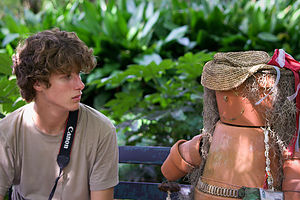 Tommy sharing bench with art - AJGThe walkways through the main garden are designed in the shape of a butterfly with outspread wings, all leading back to a central garden area. In addition to the butterfly garden, there are several other rectangular gardens off of it, each with a large prominent sculpture and many other smaller ones. It’s kind of like wandering through a maze with sculptures to guide you along the way. The placement of the sculptures within this beautifully landscaped setting creates an extraordinary blend of nature and art. We took many, many pictures that afternoon.
Tommy sharing bench with art - AJGThe walkways through the main garden are designed in the shape of a butterfly with outspread wings, all leading back to a central garden area. In addition to the butterfly garden, there are several other rectangular gardens off of it, each with a large prominent sculpture and many other smaller ones. It’s kind of like wandering through a maze with sculptures to guide you along the way. The placement of the sculptures within this beautifully landscaped setting creates an extraordinary blend of nature and art. We took many, many pictures that afternoon.
My favorite is still the Fountain of the Muses, a series of four whimsical figures in a pool, representing the four muses of the fine arts: poetry, architecture, music, and painting. Every time we visit, we can’t resist mimicking their poses for a family photograph. Well, actually Herb and I can’t resist—the boys hate it. They reluctantly agreed once more, but only after we promised that we wouldn’t use it as our 2009 Christmas card shot.
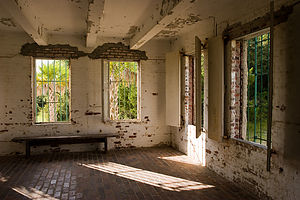 Atalaya Castle interior viewIt was closing time, so we drove across the highway to the State Park where we had a camping reservation for the night. We were surprised to find that the campground along the beach that we had stayed in back in 2001 had been closed for ecological reasons, and the only camping area remaining was the one that was set back a little more from the ocean. It was still very nice and just a short walk over a boardwalk to the beach.
Atalaya Castle interior viewIt was closing time, so we drove across the highway to the State Park where we had a camping reservation for the night. We were surprised to find that the campground along the beach that we had stayed in back in 2001 had been closed for ecological reasons, and the only camping area remaining was the one that was set back a little more from the ocean. It was still very nice and just a short walk over a boardwalk to the beach.
Our time here was too short to let a little inconvenience like dinner get in our way, so we went straight to the beach. It was still very warm out and the surf was just the way I like it. Even after seeing many of the beautiful beaches of Florida, this one is still near the top of our list.
The boys went off for a run while Herb and I went for a walk over to Atalaya, the old gray Moorish castle which was once the Huntington’s winter home. This place must have been something in its day, but sadly it is now in much need of repair. On our past trip here in 2001, the door wasn’t locked and we were allowed to just wander through the gray-stone passageways on our own, but now it is restricted to certain hours and there is an admission fee.
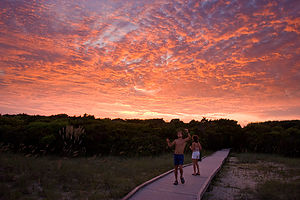 Andrew & Lolo enjoying sunsetAfter Atalaya, we decided to walk back to the campground along the beach. I can’t even begin to give justice in words to the incredible sky that preceded sunset that night. It started out as a typical mackerel sky, but then we watched as its color transformed from white to pink to a vibrant red. Andrew came back from his run and met us on the beach just in time to see it. Tommy, unfortunately, had gone directly to the shower. Andrew took off his sneakers, swam out past where the waves were breaking, and just floated on his back gazing up at the sky. Every trip usually has its peak moment, and for Andrew this was his. I was so jealous that I didn’t have my bathing suit on.
Andrew & Lolo enjoying sunsetAfter Atalaya, we decided to walk back to the campground along the beach. I can’t even begin to give justice in words to the incredible sky that preceded sunset that night. It started out as a typical mackerel sky, but then we watched as its color transformed from white to pink to a vibrant red. Andrew came back from his run and met us on the beach just in time to see it. Tommy, unfortunately, had gone directly to the shower. Andrew took off his sneakers, swam out past where the waves were breaking, and just floated on his back gazing up at the sky. Every trip usually has its peak moment, and for Andrew this was his. I was so jealous that I didn’t have my bathing suit on.
The next morning, we paid the small admission fee and walked through the stone passageways of Atalaya before heading over once more for a final visit to Brookgreen Gardens. Then it was on to the final stop of our trip: our very good friends’ home in Virginia Beach.
Description
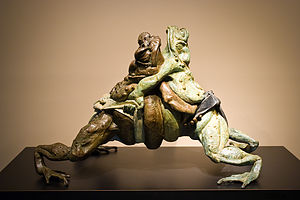 Sumo Frogs SculptureHuntington Beach State Park and Brookgreen Gardens lie on either side of U.S. 17 about 20 miles south of Myrtle Beach.
Sumo Frogs SculptureHuntington Beach State Park and Brookgreen Gardens lie on either side of U.S. 17 about 20 miles south of Myrtle Beach.
This 25,000-acre coastal wilderness was once owned by the sculptress Anna Hyatt Huntington and her railroad-magnate husband Archer Huntington. In 1931, they purchased this property, which was once a rice plantation, in order to preserve the local flora and fauna as well as to build a winter home and studio on the beach. They wintered in their Moorish-style castle, called Atalaya until Archer Huntington died in 1955. After that, Anna Huntington moved her studio across the highway to Brookgreen Gardens, where she died in 1973. The Trustees of Brookgreen leased the 2,500 acres along the coast to the state of South Carolina and it became a state park.
Huntington Beach State Park
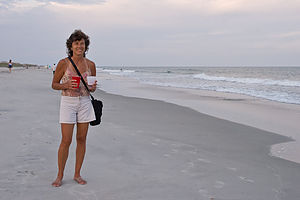 Lolo on Huntington Beach with 2 drinksWhen you enter the park, the road winds through a dense forest and then emerges onto a causeway with a freshwater lagoon on your right and a saltwater marsh on your left. Alligators are often spotted on the freshwater side of the causeway.
Lolo on Huntington Beach with 2 drinksWhen you enter the park, the road winds through a dense forest and then emerges onto a causeway with a freshwater lagoon on your right and a saltwater marsh on your left. Alligators are often spotted on the freshwater side of the causeway.
Left of the causeway is a parking area for a boardwalk that extends 500 feet out onto the salt marsh to a covered viewing deck. This is a popular area for crabbing. From this same parking area, the 1.5-mile Sandpiper Trail leads the opposite direction into a forest of live oaks and loblolly pines. The trail eventually crosses the dunes and heads north along the beach. At the very northern end of the beach is a jetty, which is a good place to fish for flounder and spottail bass.
Right of the causeway is the 2-story beach pavilion and popular day use beach area. Next to the beach are the remains of a Atalaya, a Moorish-style castle which was once the Huntington’s winter home. It is open daily for tours. The state park also has a 107-site campground, a short walk to the beach.
Huntington Beach State Park contains 3 miles of some of the nicest and best preserved beaches along South Carolina’s Grand Strand. In addition to the excellent swimming on this beach, there is biking along its hard sand.
Brookgreen Gardens
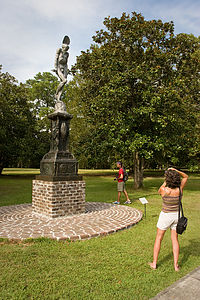 Lolo photographing statueRight across the highway from the state park are the sculpture gardens and wildlife preserve of Brookgreen Gardens, founded in 1931 by Archer and Anna Hyatt Huntington.
Lolo photographing statueRight across the highway from the state park are the sculpture gardens and wildlife preserve of Brookgreen Gardens, founded in 1931 by Archer and Anna Hyatt Huntington.
Today Brookgreen Gardens is a National Historic Landmark with one of the most significant collections of figurative sculpture by American artists in an outdoor setting. The collection currently contains over 900 works, spanning the entire period of American sculpture, from the early 1800s to the present.
The Huntingtons planned the garden walks in the shape of a butterfly with outspread wings, all leading back to the central space, which was the site of the original plantation house. The placement of sculptures within these beautifully landscaped settings creates an extraordinary blend of nature and art. In addition to the sculpture collection in the gardens, there are also two indoor sculpture galleries.
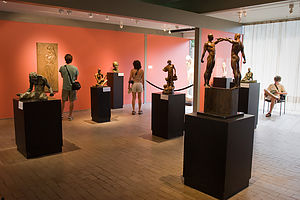 Family enjoying sculpture competitionAlthough the sculpture gardens are the focal point of the park, there are thousands of acres of forested swamps, salt marshes, and fresh tidal swamps to explore in Brookgreen’s Lowcountry History and Wildlife Preserve. The natural habitats in the preserve include a waterfowl aviary built over a cypress swamp, a bird of prey aviary, a river otter pond, an alligator swamp, a fox glade, a wild turkey exhibit, and a white-tailed deer savannah. In addition to exhibits of the native animals that populated this region, there is a domestic animals exhibit with examples of historic rare breed animals that were commonly seen on plantations in the 18th and 19th century, such as Red Devon milking cows, Tunis sheep, Dominique chickens, and Guinea fowl.
Family enjoying sculpture competitionAlthough the sculpture gardens are the focal point of the park, there are thousands of acres of forested swamps, salt marshes, and fresh tidal swamps to explore in Brookgreen’s Lowcountry History and Wildlife Preserve. The natural habitats in the preserve include a waterfowl aviary built over a cypress swamp, a bird of prey aviary, a river otter pond, an alligator swamp, a fox glade, a wild turkey exhibit, and a white-tailed deer savannah. In addition to exhibits of the native animals that populated this region, there is a domestic animals exhibit with examples of historic rare breed animals that were commonly seen on plantations in the 18th and 19th century, such as Red Devon milking cows, Tunis sheep, Dominique chickens, and Guinea fowl.
One can either explore the grounds and gardens of Brookgreen on their own, or join one of the many tours or programs that are part of the admission price. For an additional fee, Brookgreen also offers daily excursions along the rice fields on the Springfield, a 48-foot pontoon boat, and overland through old plantation sites on an all terrain vehicle called the Trekker.
Anastasia State Park
Sunday, August 16, 2009 - 12:45pm by Lolo414 miles and 7 hours from our last stop - 1 night stay
Travelogue
 Mom and Dad on Anastasia Beach - TJG7 hours of driving was just about enough. That would give us some time to have fun today, and only leave us with another 6 hours to get to Huntington Beach tomorrow, enough time to have some fun there as well. The flat tire we had along the way didn’t exactly improve our timing.
Mom and Dad on Anastasia Beach - TJG7 hours of driving was just about enough. That would give us some time to have fun today, and only leave us with another 6 hours to get to Huntington Beach tomorrow, enough time to have some fun there as well. The flat tire we had along the way didn’t exactly improve our timing.
Since it was already close to 4:00 when we arrived at the park, we headed directly to the beach rather than stop at the campground. That’s the nice part about RV camping—there is no need to check-in and unpack. You’re always checked in.
As we walked towards the beach, we noticed the two pretty flags flapping in the breeze at the end of the walkway, one yellow and one purple. Florida uses a system of warning flags to alert beach-goers to any possible hazards. The yellow flag indicated a moderate hazard due to high surf and strong currents, probably the result of the tropical storm that had chased us from Key West. That one I could deal with. It was the purple one, which meant “Dangerous marine life” that I didn’t like. Marine life is a pretty broad term; I wanted specifics.
Not sharing my sense of urgency in the matter, the Gaidus men settled into their beach chairs, while I, and my maternal need to protect the family, strutted off down the beach towards the lifeguard stand. “Excuse me, but exactly what kind of marine life are we concerned with here?” I asked the young lifeguard, fully expecting to hear the dreaded word “sharks.” I think it was even Shark Week on the Discovery Channel. “Jellyfish,” he replied. “But don’t worry, they can’t kill you. It’s kind of like just getting a bee sting.” I didn’t want a bee sting.
 Herb on Anastasia Beach - LEGI reported back to the men. They told me they weren’t going in anyway. It was late in the afternoon and they were going for a run—two of them anyway. Herb would have a beer and man the beach.
Herb on Anastasia Beach - LEGI reported back to the men. They told me they weren’t going in anyway. It was late in the afternoon and they were going for a run—two of them anyway. Herb would have a beer and man the beach.
I decided to ride my bike along with the boys to get some exercise while still keeping up with them. Since today was their long run day, I suggested running the 4 miles into the Old Town of St. Augustine.
Just getting from the beach to the park entrance was over a mile and a half. This was a very large park. From the park entrance we made a right onto Anastasia Boulevard and ran, or rode, another mile and a half to the Bridge of Lions into the Old Town. I must say that the section along Anastasia Blvd was a bit dicey. Finally at the Bridge, where you could look across the inlet to the historic buildings of Old Town, things got pretty interesting. It was like entering a totally new—or more appropriately old—world. The first landmark on our right as we came over the bridge was the Castillo de San Marcos, a huge military fortress built by the Spanish in 1672. We continued through a nice park and then along some cobblestone streets past several Spanish Colonial era buildings. A little Fountain of Youth juice would have hit the spot about now, but I knew from a previous trip here that that was well over a mile north of the bridge. Then it was back over the bridge, along the same cheesy Boulevard, and back to the campground. Before actually entering the campground, we made a side trip to see the Lighthouse.
 Herb and Boys on relaxing on beach - LEGOnce we entered the State Park, I rode ahead and told the boys that I would meet them at the campsite. We hadn’t been there yet, but we knew the site number. I had to ride over a mile back towards the beach to get to the campground road. From there the campground road doubled back so now I was going the exact opposite direction that I just come from. The campground road seemed to just go on and on and on. It was the kind of campground that had loops off the main road, and our site was on the 6th and final loop. The 6th loop was another mile from the start of the campground road. Ironically, when I looked at a campground map, I saw that we were literally just about 100 yards away from the campground office near the entrance. If only I had known and could have cut through the forest, I could have saved myself 2 ½ miles. This really was going to be a long run for the boys.
Herb and Boys on relaxing on beach - LEGOnce we entered the State Park, I rode ahead and told the boys that I would meet them at the campsite. We hadn’t been there yet, but we knew the site number. I had to ride over a mile back towards the beach to get to the campground road. From there the campground road doubled back so now I was going the exact opposite direction that I just come from. The campground road seemed to just go on and on and on. It was the kind of campground that had loops off the main road, and our site was on the 6th and final loop. The 6th loop was another mile from the start of the campground road. Ironically, when I looked at a campground map, I saw that we were literally just about 100 yards away from the campground office near the entrance. If only I had known and could have cut through the forest, I could have saved myself 2 ½ miles. This really was going to be a long run for the boys.
The campsite really was quite nice and very private. However, I think the park brochure is exaggerating a bit when they say the campground is a short walk to the beach. That’s certainly not the case if you’re in loop 6.
Description
 Mom and Dad enjoying surf - TJGAnastasia State Park is located on Anastasia Island, just south of historic St. Augustine. The park has 4 miles of pristine beaches and a lagoon bordered by rich tidal marshes.
Mom and Dad enjoying surf - TJGAnastasia State Park is located on Anastasia Island, just south of historic St. Augustine. The park has 4 miles of pristine beaches and a lagoon bordered by rich tidal marshes.
Activities in the park include:
- Ocean swimming at a beautiful white sand beach
- Windsurfing in the lagoon
- Canoeing and kayaking
- Fishing
The park contains a large wooded campground within bicycling distance to the beach.

